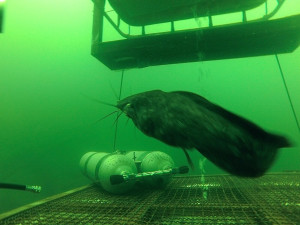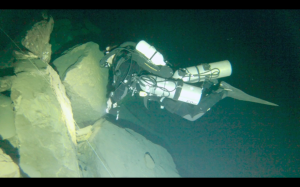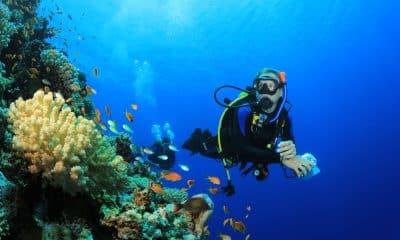News
Deep Cave Dive at Song Hong, Thailand

There’s a certain feeling that arises when tying into the end of a deep cave line. As you are laying new line in virgin cave, there’s this unmistakable burst of adrenaline being injected into your system. You can feel your heartbeat, your synapses sharpen and you can clearly hear every sound, click and hiss the rebreather makes.
This time is no different.
Mike Gadd had a double scooter failure in Song Hong around the 135m mark as the pressure had made the o-rings squeeze the propeller axe to a halt.
I decide to scooter to 120m to save time, drop the scooter, then swim to the last tie off.
It takes me only 8 minutes to arrive at the end of the line at 153m, the same one Pekka and myself laid a good half year ago.
The video showed a drop into a black void. I tie off into the last arrow and start laying out line. The viz isn’t that good, around 20meters as opposed to the 40m in the shallower parts and the drop isn’t that steep. Instead I’m facing a lunar landscape of rocks strewn around on a perfectly polished beach.
I negotiate my way between the rocks whilst tying off every 10m.
After another 8 minutes, the bottom seems to go up again and I decide I’m far enough for now. My double twenty litre stage tanks allow for a 20 minute swim back to the 90m mark. I also carry two 300 bar carbon tanks on my butt d-ring. As they are positively buoyant, they carry a bit of the weight of all the equipment. I make a final tie off at 177M just above a small hole. I cut the line, place an arrow and start swimming back. With one hand freed, I can now turn on my 11000Lumenvideo light to look at the bottom. In the bottom of the landscape I see multiple black holes which are just too small to swim through. The question is, where are these holes going? Is there another passage below this level?
Then in the corner of my eye I see something crawl away. 5m further I see something else and I move closer. A white-pink millipede-like worm crawls over the sandy bottom. It’s about 2 inches long. Yes, it is just a worm, but, in 6 years of diving in song hong, I have never seen any living creature below 25m. Thermoclines and different dissolved gasses make it basically impossible for any creature to sustain life below these levels, except for some bacteria clusters feeding off hydrogen sulphide and Co2…. yet, at these depths, there is this worm having its own empire.
I make my way back past the 150m mark and face a dilemma; both my computers show completely different decompression stops/profiles. My plan correlates most with my old computer, but I don’t want to ‘bend’ my other computer, so I start doing the deep stops. First stop is at 126m… 15 minutes later, I’m still crawling with 3m increments and only just past the 100m mark. My other computer has now added another hour of deco; 6 hours to go. Not good. I won’t be home in time for dinner, so I decide to fall back on my old trusted computer and my plan. 5 minutes later the first computer tells me I’m dead, whereas I see a little smiley face on the older one.
Miscommunication with the support crew means that my back up air supply is not at the 50m mark as discussed. The briefing was too hastily done and I curse myself for not having written it down.
I had a light trimix in my drysuit to keep me a little cool during all the finning at the bottom, but I’m now cooling down rapidly. The air tank also had my isotonic drinking bag on it and I start to get cramp in my right foot. This is mainly because of loss of fluids and salts, but also because of the vasoconstrictive effect high oxygen exposure has on your extremities, limiting blood flow.
As I arrive too late at the rendezvous point, I just catch a glimpse of the safety diver, who quickly signals an ok sign with his torch and disappears. He has been waiting at the 50m mark longer than anticipated because of the extra deco my computer gave.
Finally, at the 20m marker I get my air and my fluids. I feel warm and hydrated within 15 minutes and back on the happy track.
Once at the 12m area, I can offload most tanks on the custom platforms that are cable suspended at 12 and 9m with a habitat/bell at 8m of depth.
After 4 hours I finally reach the habitat. Cameron helps me to get out of my rebreather and into the habitat, where I start breathing pure oxygen. The air in the habitat is being ‘cleaned’ with a custom scrubber and a computer fan powered by a motorbike battery.
I’m out of the water waist up, my pee valve is below the surface and a big catfish keeps me company on the seat next to me, attracted to what comes out of the pee valve. Multivitamins and electrolytes tend to colour urine fluorescent yellow and I wonder if that is it what attracts the catfish. He remains unfazed as I’m being served hot lasagna… I forgot to put a spoon in the bag and try to scoop the lasagne with the lid of the box. Next time Cameron surfaces inside the habitat he pictures a massacre as my face is covered with lasagne and he nearly chokes in his regulator.
After another 2 hours I crawl back into my rebreather and slowly surface. I get a mild pain in my knees when surfacing, something I had as well on the 239m dive after 3 hours in the habitat. I guess my knees should keep moving during deco instead of sitting down to promote the helium getting out of my joints. The pain goes away quickly; I crawl into the truck and fall asleep.
Max depth; 177
Runtime: 366minutes
Number of gasses carried: 7
At this moment, the shape of the main tunnel remains a mystery. Earlier dives revealed another drop below the ‘slope’ that characterises both sides of the tunnel. If so, then the tunnel would have the shape of a ‘keyhole’, with a much deeper bottom. The width measured on a scooter (very inaccurate) is roughly 200m, where the height is approx. 100m. Rather vast.
Gear News
Introducing the TR-80, IR-50 and CS-30 Regulators from DYNAMICNORD

Whether you are a beginner or a professional diver – with the three new main regulators from DYNAMICNORD, everyone will find their favourite regulator. They all look super stylish.
Excellent performance with the TR-80
Quality and performance are the be-all and end-all for regulators. It is not for nothing that the TR stands for Tec Reg. The innovative design of the TR-80 guarantees absolute reliability – even in ice-cold waters.

Perfect breathing effort at 0.8 J/l / certified for diving in waters below 10 degrees / structural design made of solid brass for best cold protection / membrane-compensated design with dry seal of the first stage / reduced exhalation effort thanks to optimized exhalation membrane and bubble deflector / adjustable Venturi (dive/predive) and adjustment knob for individual inhalation comfort / innovative design of the front cover prevents free-flow in strong currents or when diving with scooters / design made of sandblasted brass, matt chrome finish / 2 HP and 4 LP outlets / mouthpiece made of high-quality, anti-allergic silicone for maximum comfort.


Amazing underwater adventures with the IR-50
The IR-50 is the top regulator for advanced and experienced divers. Natural breathing is the essence of this regulator.

Ideal breathing effort at 0.8 J/l /certified for diving in waters below 10 degrees / compensated membrane / adjustable venturi (dive/predive) and adjustment knob for individual inhalation comfort/ outlet valve and deflector for minimum exhalation effort and reduction of bubbles on the face / design made of sandblasted brass, matt chrome finish / 2 HP and 4 NP outlets / mouthpiece made of high-quality, anti-allergic silicone for maximum comfort.


The Workhorse – our CS-30
For diving centres and diving beginners – the workhorse stands for strong construction, reliability and robustness. Perfect for your training.

Optimal breathing effort at 0.8 J/l /recommended for diving in waters above 10 degrees / non-compensated piston / adjustable venturi (dive/predive) / outlet valve and deflector for minimum exhalation effort and reduction of bubbles on the face / design made of sandblasted brass, matt chrome finish / 1 HP and 3 NP outlets / mouthpiece made of high-quality, anti-allergic silicone for maximum comfort.


Octopus OP-30
The OP-30 is the ideal addition to all DYNAMICNORD regulators. It is identical in construction to the CS-30.

The TR-80, IR-50, CS-30 (DIN & INT) regulators and the Octopus OP-30 are available from DYNAMICNORD dealers and in the online store.
DYNAMICNORD – Your Outdoor Companion.
Marine Life & Conservation
Paul Watson Released as Denmark Blocks Japan’s Extradition Bid

Renowned anti-whaling activist Paul Watson has been released from custody in Greenland after spending five months in detention. Denmark’s Justice Ministry rejected Japan’s request for his extradition, citing insufficient guarantees that his time already served in custody would be credited against any potential sentence.
The 74-year-old Canadian-American was arrested on July 21 in Nuuk, Greenland’s capital, when his ship docked to refuel. His arrest was based on a 2012 Japanese warrant related to a 2010 encounter in Antarctic waters. Japan alleged Watson obstructed operations and caused damage to a whaling research ship during efforts to disrupt illegal whaling. Watson has consistently denied these claims, maintaining his commitment to marine conservation.
Denmark, which oversees extradition matters for Greenland, concluded that while the legal conditions for extradition were met, the lack of assurances from Japan regarding time-served credit made extradition untenable.
In a video shared by his foundation, Watson expressed gratitude and relief, saying, “After five months, it’s good to be out… and good to know they’re not sending me to Japan.” He added that the most difficult part of his time in custody was being separated from his two young sons.
Watson is a pioneering figure in marine conservation, known for founding the Captain Paul Watson Foundation in 2022 after decades of activism with the Sea Shepherd Conservation Society. His bold efforts to defend marine life have earned him widespread support, including from celebrities and conservationists. His work has also been featured in the acclaimed reality TV series Whale Wars.
Watson’s lawyer, Jonas Christoffersen, praised the decision, stating, “We are happy and relieved that Paul Watson is now free.” He added that Watson is eager to reunite with his family and continue his vital work.
The arrest occurred while Watson’s vessel, the M/Y John Paul DeJoria, was en route to the North Pacific with a team of 26 volunteers to intercept a Japanese whaling ship. His foundation described the arrest as politically motivated and emphasized that Watson’s actions were focused on ending illegal whaling practices.
Japan resumed commercial whaling in 2019 after leaving the International Whaling Commission, asserting that whale meat is a cultural tradition. Conservationists, however, continue to challenge these practices, highlighting their impact on marine ecosystems.
Despite the challenges, Watson remains steadfast in his mission to protect marine life and bring attention to whaling practices. His dedication to ocean conservation has made him a globally respected advocate for the environment.
-

 News2 months ago
News2 months agoIconic SS United States to become the World’s Largest Artificial Reef
-

 News3 months ago
News3 months agoBook Review – 52 Assignments: Underwater Photography
-

 Gear News3 months ago
Gear News3 months agoDYNAMICNORD – New German diving brand enters the British market
-

 News3 months ago
News3 months agoExploring Cenote El Pit: A Diver’s Dream
-

 Gear News3 months ago
Gear News3 months agoTry BARE drysuits (and maybe even win one!) this Friday with Sea & Sea at North West Dive Fest
-

 Marine Life & Conservation3 months ago
Marine Life & Conservation3 months agoBook Review: Coral Triangle Cameos
-

 Blogs2 months ago
Blogs2 months agoDive the Egyptian Red Sea this Autumn with Regaldive
-

 News3 months ago
News3 months ago2024 Ocean Art Underwater Photo Competition Announced



















